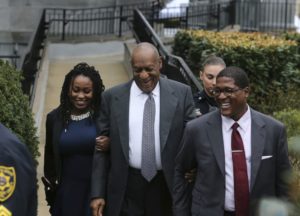
Bill Cosby, center, leaves hearings for jury selection in his sexual assault retrial with spokesperson Andrew Wyatt, right, Tuesday, April 3, 2018, at the Montgomery County Courthouse in Norristown, Pa. (AP Photo/Mel Evans)
NORRISTOWN, Pa. (AP) — Bill Cosby’s lawyers challenged the prosecution’s exclusion of a black woman from serving on the jury at his sexual assault retrial, alleging on Wednesday that the decision was made on the basis of her race.
Prosecutors pushed back, noting two blacks have been already been seated on the panel that will sit in judgment of the 80-year-old comedian. The judge said he didn’t believe the prosecution had any “discriminatory intent” but halted the third day of jury selection to consider the defense argument.
Cosby’s lawyers had appeared ready to strike at the first instance of prosecutors blocking a black juror, producing a legal brief that argued the move violated a 32-year-old Supreme Court ruling that prohibits prosecutions from excluding prospective jurors because of their race. The defense had made the same argument on Tuesday regarding the prosecution’s exclusion of several white men, but Judge Steven O’Neill rejected it.
The legal maneuvering came as lawyers picked an eighth juror, a white woman who was at first hesitant to guarantee she could block out what she’s read and seen about the Cosby case and the #MeToo movement against sexual misconduct.
“I could try. I mean, it’s still in my head,” she explained, before eventually agreeing.
The jury so far consists of six whites and two blacks. Four jurors are men and four are women.
A dozen people were invited back for individual questioning Wednesday as the prosecution and defense looked to fill the remaining spots. A third batch of 120 potential jurors was also called to the courthouse in suburban Philadelphia.
Cosby chatted with lawyer Kathleen Bliss in court, saying, “How are you this morning?” She replied, “bright eyed and bushy tailed.” He then feigned a glance behind her, as if looking for a tail.
Cosby has pleaded not guilty to charges he drugged and molested Andrea Constand at his suburban Philadelphia home in 2004. He says the encounter with the former Temple University women’s basketball administrator was consensual.
No major rulings were expected Wednesday after the trial judge opened Tuesday’s session by issuing decisions favorable to a defense team that is trying to cast Cosby as the victim of a shakedown scheme involving false accusations of sexual assault.
O’Neill granted the Cosby’ team’s request to call a woman who says Constand talked about framing a celebrity before she lodged allegations against him in 2005. The judge also ruled that jurors can hear how much Cosby paid Constand in a 2006 civil settlement.
O’Neill’s ruling allowing Marguerite Jackson to testify was at odds with his decision to block her from the first trial, which ended in a hung jury. O’Neill did not explain his change of heart but issued one caveat, saying he could revisit her testimony after Constand takes the stand.
During the first trial, O’Neill ruled that Jackson’s testimony would be hearsay after Constand testified she did not know the woman. Since then, prosecutors have told Cosby’s lawyers that Constand had modified her statement to acknowledge she “recalls a Margo.”
Jackson, a longtime Temple University official, has said that she and Constand worked closely together, had been friends and had shared hotel rooms several times. Jackson says Constand once commented to her about setting up a “high-profile person” and filing a lawsuit.
Constand’s lawyer has said Jackson is not telling the truth.
Jackson’s availability as a witness for Cosby could be crucial to a defense plan to attack Constand’s credibility.
O’Neill previously gave a boost to the prosecution, ruling they can call five additional accusers in a bid to portray Cosby — the former TV star once revered as “America’s Dad” for his family sitcom “The Cosby Show” — as a serial predator.
The AP does not typically identify people who say they are victims of sexual assault unless they grant permission, which Constand has done.
As Wednesday’s session got underway, a judge gave The Associated Press and other media organizations more access to jury selection.
Media lawyers had challenged an arrangement that forced reporters to watch the group questioning part of the process on a closed-circuit feed from another courtroom. The camera showed the judge, prosecutors and defense lawyers, but not potential jurors who were being questioned as a group.
Montgomery County President Judge Thomas DelRicci agreed to move the camera to the back of the courtroom so the media could see the potential jurors. The judge refused to make room in the crowded courtroom for a pool reporter, but said if the jury pool did not fill the room to capacity, he’d allow reporters to attend live.


